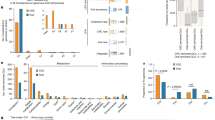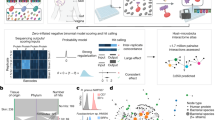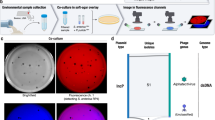Abstract
New antibiotics are urgently needed to control infectious diseases. Metabolic enzymes could represent attractive targets for such antibiotics, but in vivo target validation is largely lacking. Here we have obtained in vivo information about over 700 Salmonella enterica enzymes from network analysis of mutant phenotypes, genome comparisons and Salmonella proteomes from infected mice. Over 400 of these enzymes are non-essential for Salmonella virulence, reflecting extensive metabolic redundancies and access to surprisingly diverse host nutrients. The essential enzymes identified were almost exclusively associated with a small subgroup of pathways, enabling us to perform a nearly exhaustive screen. Sixty-four enzymes identified as essential in Salmonella are conserved in other important human pathogens, but almost all belong to metabolic pathways that are inhibited by current antibiotics or that have previously been considered for antimicrobial development. Our comprehensive in vivo analysis thus suggests a shortage of new metabolic targets for broad-spectrum antibiotics, and draws attention to some previously known but unexploited targets.
This is a preview of subscription content, access via your institution
Access options
Subscribe to this journal
Receive 51 print issues and online access
$199.00 per year
only $3.90 per issue
Buy this article
- Purchase on Springer Link
- Instant access to full article PDF
Prices may be subject to local taxes which are calculated during checkout



Similar content being viewed by others
References
Norrby, S. R., Nord, C. E. & Finch, R. Lack of development of new antimicrobial drugs: a potential serious threat to public health. Lancet Infect. Dis. 5, 115–119 (2005)
Black, M. T. & Hodgson, J. Novel target sites in bacteria for overcoming antibiotic resistance. Adv. Drug Deliv. Rev. 57, 1528–1538 (2005)
Hughes, D. Exploiting genomics, genetics and chemistry to combat antibiotic resistance. Nature Rev. Genet. 4, 432–441 (2003)
Guimera, R. & Nunes Amaral, L. A. Functional cartography of complex metabolic networks. Nature 433, 895–900 (2005)
Price, N. D., Reed, J. L. & Palsson, B. O. Genome-scale models of microbial cells: evaluating the consequences of constraints. Nature Rev. Microbiol. 2, 886–897 (2004)
Badarinarayana, V. et al. Selection analyses of insertional mutants using subgenic-resolution arrays. Nature Biotechnol. 19, 1060–1065 (2001)
Kuepfer, L., Sauer, U. & Blank, L. M. Metabolic functions of duplicate genes in Saccharomyces cerevisiae. Genome Res. 15, 1421–1430 (2005)
Thomson, C. J., Power, E., Ruebsamen-Waigmann, H. & Labischinski, H. Antibacterial research and development in the 21st Century—an industry perspective of the challenges. Curr. Opin. Microbiol. 7, 445–450 (2004)
Bhan, M. K., Bahl, R. & Bhatnagar, S. Typhoid and paratyphoid fever. Lancet 366, 749–762 (2005)
O'Ryan, M., Prado, V. & Pickering, L. K. A millennium update on pediatric diarrheal illness in the developing world. Semin. Pediatr. Infect. Dis. 16, 125–136 (2005)
Hapfelmeier, S. & Hardt, W. D. A mouse model for S. typhimurium-induced enterocolitis. Trends Microbiol. 13, 497–503 (2005)
Santos, R. L. et al. Animal models of Salmonella infections: enteritis versus typhoid fever. Microbes Infect. 3, 1335–1344 (2001)
McClelland, M. et al. Complete genome sequence of Salmonella enterica serovar Typhimurium LT2. Nature 413, 852–856 (2001)
Porwollik, S., Santiviago, C. A., Cheng, P., Florea, L. & McClelland, M. Differences in gene content between Salmonella enterica serovar Enteritidis isolates and comparison to closely related serovars Gallinarum and Dublin. J. Bacteriol. 187, 6545–6555 (2005)
Deng, W. et al. Comparative genomics of Salmonella enterica serovar Typhi strains Ty2 and CT18. J. Bacteriol. 185, 2330–2337 (2003)
Parkhill, J. et al. Complete genome sequence of a multiple drug resistant Salmonella enterica serovar Typhi CT18. Nature 413, 848–852 (2001)
McClelland, M. et al. Comparison of genome degradation in Paratyphi A and Typhi, human-restricted serovars of Salmonella enterica that cause typhoid. Nature Genet. 36, 1268–1274 (2004)
Keseler, I. M. et al. EcoCyc: a comprehensive database resource for Escherichia coli. Nucleic Acids Res. 33, D334–D337 (2005)
Knuth, K., Niesalla, H., Hueck, C. J. & Fuchs, T. M. Large-scale identification of essential Salmonella genes by trapping lethal insertions. Mol. Microbiol. 51, 1729–1744 (2004)
Aebersold, R. & Mann, M. Mass spectrometry-based proteomics. Nature 422, 198–207 (2003)
Giaever, G. et al. Functional profiling of the Saccharomyces cerevisiae genome. Nature 418, 387–391 (2002)
Baumler, A. J., Kusters, J. G., Stojiljkovic, I. & Heffron, F. Salmonella typhimurium loci involved in survival within macrophages. Infect. Immun. 62, 1623–1630 (1994)
Curtiss, R. III, Nakayama, K. & Kelly, S. M. Recombinant avirulent Salmonella vaccine strains with stable maintenance and high level expression of cloned genes in vivo. Immunol. Invest. 18, 583–596 (1989)
Rollenhagen, C. & Bumann, D. Salmonella enterica highly expressed genes are disease-specific. Infect. Immun. 74, 1649–1660 (2006)
Jeong, H., Tombor, B., Albert, R., Oltvai, Z. N. & Barabasi, A. L. The large-scale organization of metabolic networks. Nature 407, 651–654 (2000)
Eriksson, S., Lucchini, S., Thompson, A., Rhen, M. & Hinton, J. C. Unravelling the biology of macrophage infection by gene expression profiling of intracellular Salmonella enterica. Mol. Microbiol. 47, 103–118 (2003)
Henry, T., Garcia-del Portillo, F. & Gorvel, J. P. Identification of Salmonella functions critical for bacterial cell division within eukaryotic cells. Mol. Microbiol. 56, 252–267 (2005)
Freiberg, C. et al. Identification of novel essential Escherichia coli genes conserved among pathogenic bacteria. J. Mol. Microbiol. Biotechnol. 3, 483–489 (2001)
Gerdes, S. Y. et al. From genetic footprinting to antimicrobial drug targets: examples in cofactor biosynthetic pathways. J. Bacteriol. 184, 4555–4572 (2002)
Heath, R. J., White, S. W. & Rock, C. O. Lipid biosynthesis as a target for antibacterial agents. Prog. Lipid Res. 40, 467–497 (2001)
Andries, K. et al. A diarylquinoline drug active on the ATP synthase of Mycobacterium tuberculosis. Science 307, 223–227 (2005)
Wendland, M. & Bumann, D. Optimization of GFP levels for analyzing Salmonella gene expression during an infection. FEBS Lett. 521, 105–108 (2002)
Bumann, D. Examination of Salmonella gene expression in an infected mammalian host using the green fluorescent protein and two-colour flow cytometry. Mol. Microbiol. 43, 1269–1283 (2002)
Acknowledgements
We thank R. Förster for support, T. Aebischer for discussion, M. Sörensen, K. Raba and C. Reimer for technical assistance, and P. Mortensen and J. V. Olsen for providing a script to calibrate the LTQ-FT data. This work was supported by grants from the Deutsche Forschungsgemeinschaft (to D. Bumann).
Author information
Authors and Affiliations
Corresponding author
Ethics declarations
Competing interests
Reprints and permissions information is available at npg.nature.com/reprintsandpermissions. The authors declare no competing financial interests.
Supplementary information
Supplementary Figure 1
Overview of Salmonella metabolism in a mouse enteritis model. (PDF 57 kb)
Supplementary Table 1
Published Salmonella mutant phenotypes in typhoid fever models. (XLS 24 kb)
Supplementary Table 2
Salmonella genes that are non-functional in serovars causing systemic disease. (XLS 23 kb)
Supplementary Table 3
Summary of functional and proteome evidence for Salmonella metabolic enzymes and pathways in typhoid fever and enteritis models. (XLS 68 kb)
Supplementary Table 4
Salmonella genes with controversial in vitro phenotypes. (XLS 18 kb)
Supplementary Table 5
Salmonella proteome data for typhoid fever and enteritis models. (XLS 168 kb)
Supplementary Table 6
Growth rates of Salmonella mutants in typhoid fever and enteritis models. (XLS 52 kb)
Supplementary Table 7
Metabolites likely to be present in Salmonella during typhoid fever and/or enteritis. (XLS 57 kb)
Supplementary Table 8
Properties of Salmonella enzymes representing potential antimicrobial targets. (XLS 57 kb)
Supplementary Table 9
Salmonella nutrition during typhoid fever and enteritis. (XLS 31 kb)
Supplementary Methods
Technical details of experimental methods used in this study. (DOC 50 kb)
Supplementary Notes
This file contains additional references. (DOC 55 kb)
Rights and permissions
About this article
Cite this article
Becker, D., Selbach, M., Rollenhagen, C. et al. Robust Salmonella metabolism limits possibilities for new antimicrobials. Nature 440, 303–307 (2006). https://doi.org/10.1038/nature04616
Received:
Accepted:
Published:
Issue Date:
DOI: https://doi.org/10.1038/nature04616
This article is cited by
-
Structural characterization of aspartate-semialdehyde dehydrogenase from Pseudomonas aeruginosa and Neisseria gonorrhoeae
Scientific Reports (2022)
-
A diet-specific microbiota drives Salmonella Typhimurium to adapt its in vivo response to plant-derived substrates
Animal Microbiome (2021)
-
IP-Based Incentives Against Antimicrobial Crisis: A European Perspective
IIC - International Review of Intellectual Property and Competition Law (2019)
-
Combined chemical genetics and data-driven bioinformatics approach identifies receptor tyrosine kinase inhibitors as host-directed antimicrobials
Nature Communications (2018)
-
Molecular evolution of an oligomeric biocatalyst functioning in lysine biosynthesis
Biophysical Reviews (2018)
Comments
By submitting a comment you agree to abide by our Terms and Community Guidelines. If you find something abusive or that does not comply with our terms or guidelines please flag it as inappropriate.



